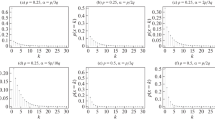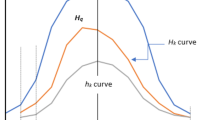Abstract
In Configural Frequency Analysis (CFA), model-data discrepancies are interpreted with reference to CFA base models. Thus far, CFA base models are defined as probability models that differ in the constraints they place on variable relations. In this article, it is proposed extending the scope of CFA base models. Specifically, it is proposed that the specification of base models is conducted with reference to data generation processes (DGPs). These processes result in uni- or multivariate distributions that reflect variable relations, probability distributions, or processes that result in change in series of observations. The new, DGP-based definition of CFA base models retains the concept of unique interpretability of CFA results, but it opens the doors to many more forms of base models than considered before. Four classes of base models are defined. Data examples illustrate various CFA base models.


Similar content being viewed by others
References
Bergman, L. R., & Magnusson, D. (1997). A person-oriented approach in research on developmental psychopathology. Development and Psychopathology, 9, 291–319.
Bogat, G. A., Levendosky, A. A., De Jonghe, E., Davidson, W. S., & von Eye, A. (2004). Pathways of suffering: The temporal effects of domestic violence on women’s mental health. Maltrattamento e Abuso All’infanzia, 6, 97–112.
Cleveland, W. S. (1979). Robust Locally Weighted Regression and Smoothing Scatterplots. Journal of the American Statistical Association, 74, 829–836.
Bonferroni, C. E. (1936). Teoria statistica delle classi e calcolo delle probabilità. Pubblicazioni Del R Istituto Superiore Di Scienze Economiche e Commerciali Di Firenze, 8, 3–62.
Evans, M.J., & Rosenthal, J.S. (2004). Probability and statistics. The science of uncertainty. Toronto: The university of Toronto. Retrieved on 5/22/2021 from http://www.utstat.toronto.edu/mikevans/jeffrosenthal/
Goodman, L. A. (1984). The analysis of cross-classified data having ordered categories. Harvard University Press.
Heilmann, W. R., Lienert, G. A., & Maly, V. (1979). Prediction models in configural frequency analysis. Biometrical Journal, 21, 79–86.
Hogg, P. V., Tanis, E. A., & Zimmerman, D. (2020). Probability and statistical inference (10th ed.). Pearson.
Holland, B. S., & Di Ponzio Copenhaver, M. (1987). An improved sequentially rejective Bonferroni test procedure. Biometrics, 43, 417–423.
Krauth, J. (2003). Type structures in CFA. Psychology Science, 45, 330–338.
Kutner, M. H., Nachtsheim, C. J., Neter, J., & Li, W. (2005). Applied linear statistical models (4th ed.). McGraw-Hill.
Lautsch, E., & von Weber, S. (1995). Methoden und Anwendungen der Konfigurationsfrequenzanalyse. Psychologie Verlags Union.
Lienert, G. A. (1968). Die "Konfigurationsfrequenzanalyse" als Klassifikationsmethode in der klinischen Psychologie. Vortrag auf dem 26. Kongress der Deutschen Gesellschaft für Psychologie in Tübingen 1968.
Lienert, G. A., & Krauth, J. (1973). Die Konfigurationsfrequenzanalyse als Prädiktionsmodell in der angewandten Psychologie. In H. Eckensberger (Ed.), Bericht über den 28. Kongress der Deutschen Gesellschaft für Psychologie in Saarbrücken 1972 (pp. 219 - 228). Göttingen: Hogrefe.
Lobato-Calleros, O.C., Martínez, J.M., Miranda, V.S., Rivera, H., & Serrato, H. (2007). Diseño de la evaluación del Índice Mexicano de Satisfacción del Usario del programa de abasto social de leche y del programa de estancias y garderías infantiles de la SEDESOL. Universidad Iberoamericana, México, D.F.: unpublished project report.
Perrine, M. W., Mundt, J. C., Searles, J. S., & Lester, L. S. (1995). Validation of daily self-report consumption using interactive voice response (IVR) technology. Journal of Studies on Alcohol and Drugs, 56, 487–490.
Pfister, C.-E. (2012). Théorie de probabilités. Presses polytechniques et universitaires romandes.
Schuster, C., & von Eye, A. (2000). Using log-linear modeling to increase power in two-sample Configural Frequency Analysis. Psychologische Beiträge, 42, 273–284.
Somerville, P.N. (1998). Numerical computation of multivariate normal and multivariate t-probabilities over convex regions. Journal of Computational and Graphical Statistics, 7, 529 – 544.
von Eye, A. (2002). Configural Frequency Analysis - Methods, Models, and Applications. Lawrence Erlbaum.
von Eye, A. (2004). Base models for Configural Frequency Analysis. Psychology Science, 46, 150–170.
von Eye, A., Bergman, L. R., & Hsieh, C.-A. (2015a). Person-oriented methodological approaches. In W. F. Overton & P. C. M. Molenaar (Eds.), Handbook of child psychology and developmental science - theory and methods (pp. 789–841). Wiley.
von Eye, A., & Bogat, G. A. (2004). Testing the assumption of multivariate normality. Psychology Science, 46, 243–258.
von Eye, A., & Brandtstädter, J. (1982).Systematization of results of configuration frequency analysis by minimizing Boolean functions.In H. Caussinus, P. Ettinger, & J. R. Mathieu (Eds.), Compstat 1982, part II:Short communications, summaries of posters (pp. 91–92).Wien:Physica.
von Eye, A., & Gardiner, J. C. (2004). Locating deviations from multivariate normality. Understanding Statistics, 3, 313–331.
von Eye, A., & Gutiérrez Peña, E. (2004). Configural Frequency Analysis - the search for extreme cells. Journal of Applied Statistics, 31, 981–997.
von Eye, A., & Mun, E. Y. (2003). Characteristics of measures for 2 x 2 tables. Understanding Statistics, 2, 243–266.
von Eye, A., & Mun, E.-Y. (2016). Configural Frequency Analysis for research on developmental processes. In D. Cicchetti (Ed.), Handbook of developmental psychopathology (pp. 866–921). Wiley.
von Eye, A., Rovine, M. J., & Spiel, C. (1995). Concepts of nonindependence in Configural Frequency Analysis. Journal of Mathematical Sociology, 20, 41–54.
von Eye, A., & Wiedermann, W. (2016). Direction of effects in categorical variables - A structural perspective. In W. Wiedermann & A. von Eye (Eds.), Statistics and causality: Methods for Applied Empirical Research (pp. 107–130). Wiley.
von Eye, A., & Wiedermann, W. (2021). CFA. Configural Frequency Analysis. New York: Springer (in press) (a).
von Eye, A., Wiedermann, W., Herman, K., & Reinke, W. (2021a). Local effects of intervention: A configural analysis. Prevention Science. https://doi.org/10.1007/s11121-021-01241-8
von Eye, A., Wiedermann, W., & Koller, I. (2015b). Granger Causality – Linear Regression and Logit Models. In M. Stemmler, A. von Eye, & W. Wiedermann (Eds.), Dependent data - Methods of analysis (pp. 127–148). Springer.
von Eye, A., Wiedermann, W., & von Weber, S. (2019). A hybrid approach to regime shift detection. Journal for Person-Oriented Research, 5, 37–49. https://doi.org/10.17505/jpor.2019.04
von Eye, A., Wiedermann, W., & von Weber, S. (2021). Configural analysis of oscillating progression. Journal of Person-Oriented Research. (in press)
von Weber, S., Lautsch, E., & von Eye, A. (2003). On the limits of Configural Frequency Analysis: Analyzing small tables. Psychology Science, 45, 339–354.
von Weber, S., von Eye, A., & Lautsch, E. (2004). The Type II error of measures for the analysis of 2 x 2 tables. Understanding Statistics, 3, 259–282.
Wiedermann, W., Herman, K., Reinke, W., & von Eye, A. (2021). Configural frequency trees. Development and Psychopathology; https://doi.org/10.1017/S0954579421000018
Author information
Authors and Affiliations
Corresponding author
Additional information
Publisher's Note
Springer Nature remains neutral with regard to jurisdictional claims in published maps and institutional affiliations.
Rights and permissions
About this article
Cite this article
von Eye, A., Wiedermann, W. & von Weber, S. Base Models for Configural Frequency Analysis – Data Generation Processes. Integr. psych. behav. 56, 801–821 (2022). https://doi.org/10.1007/s12124-021-09665-1
Accepted:
Published:
Issue Date:
DOI: https://doi.org/10.1007/s12124-021-09665-1




